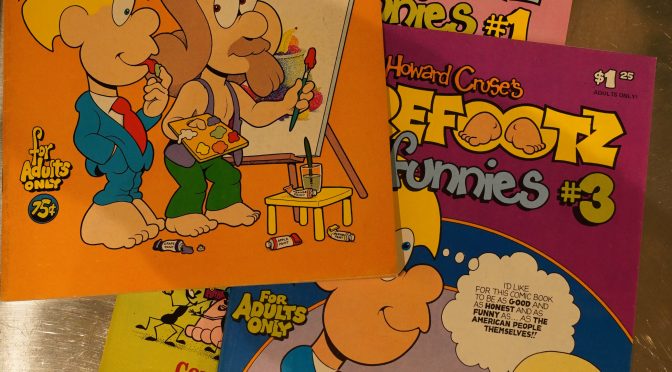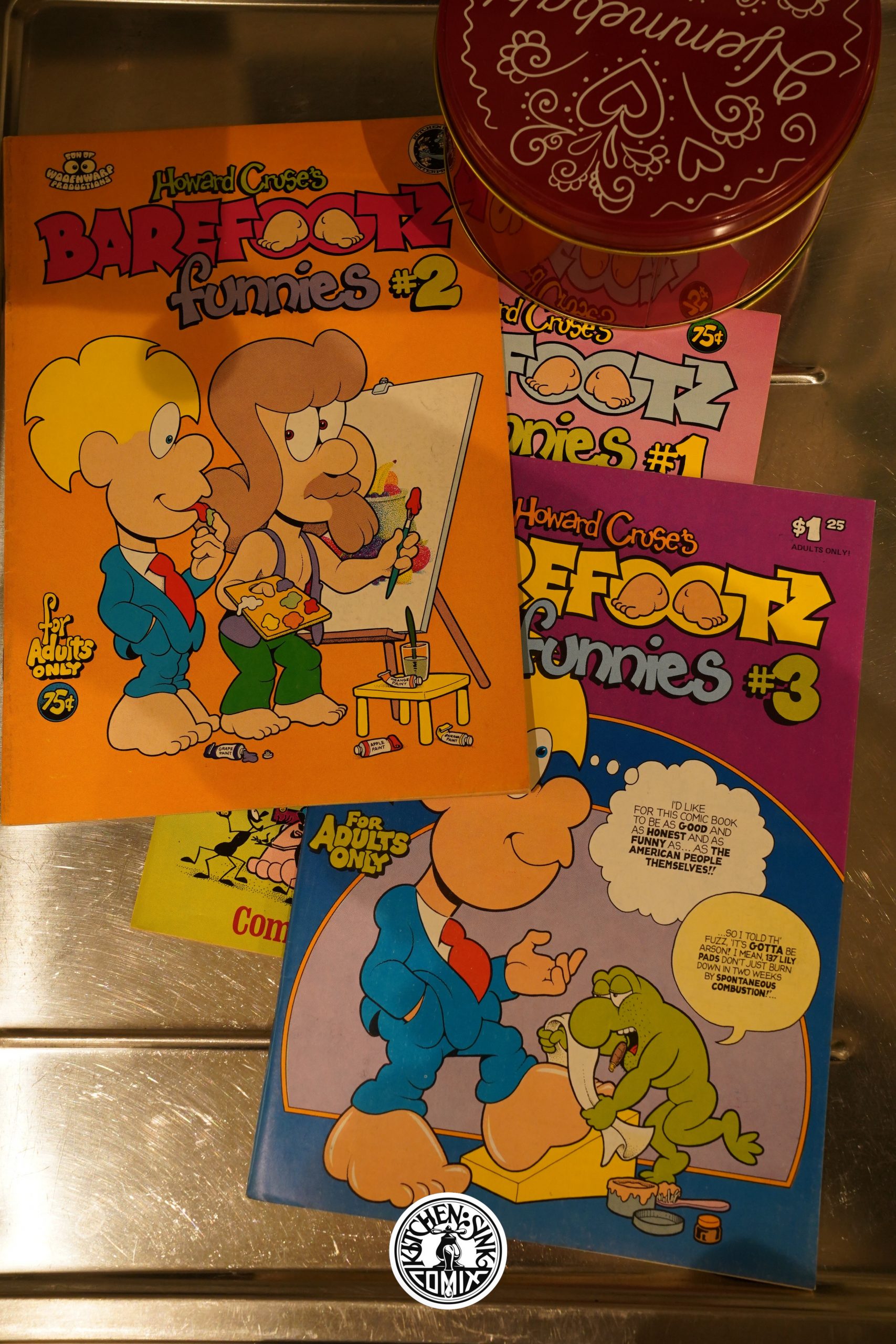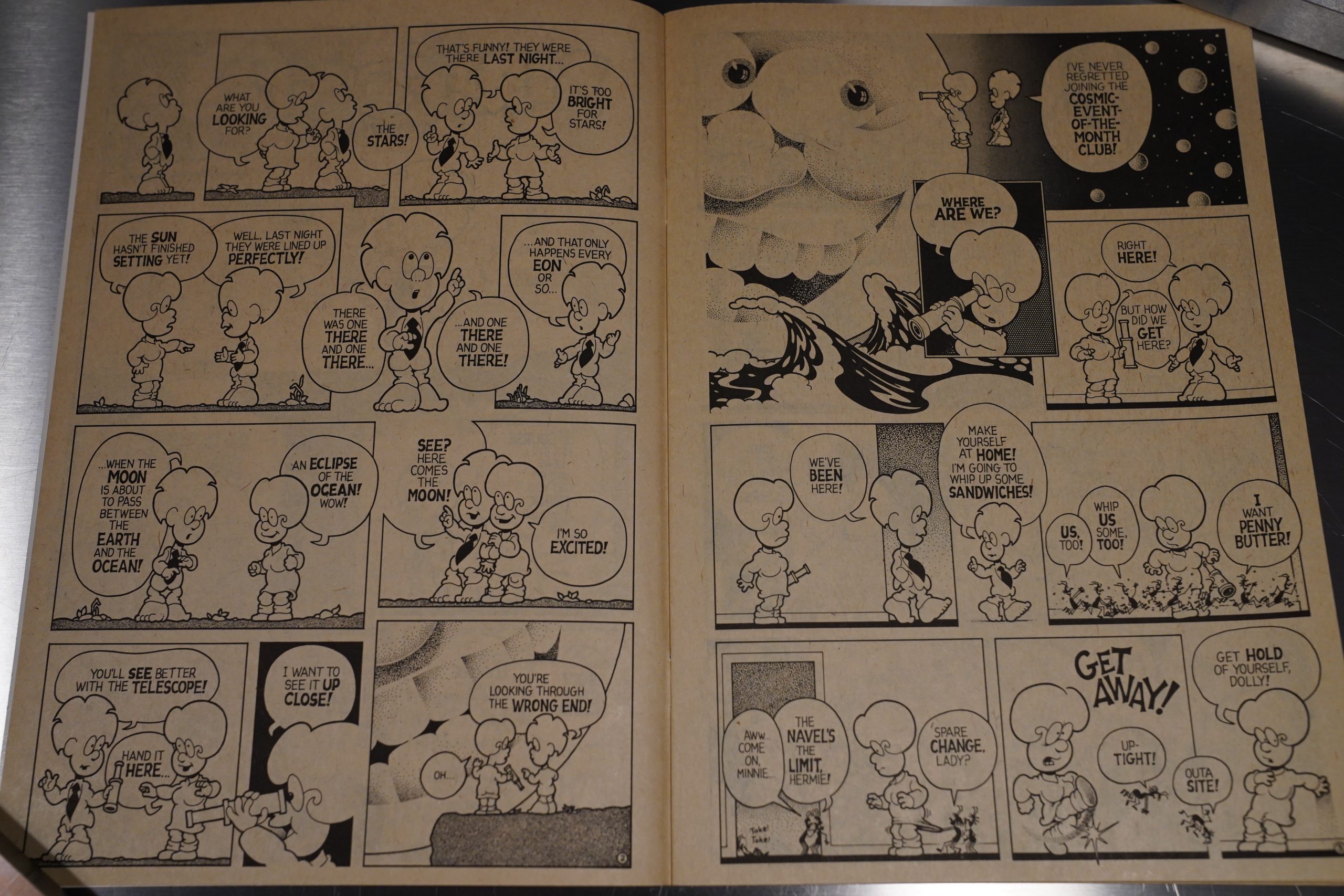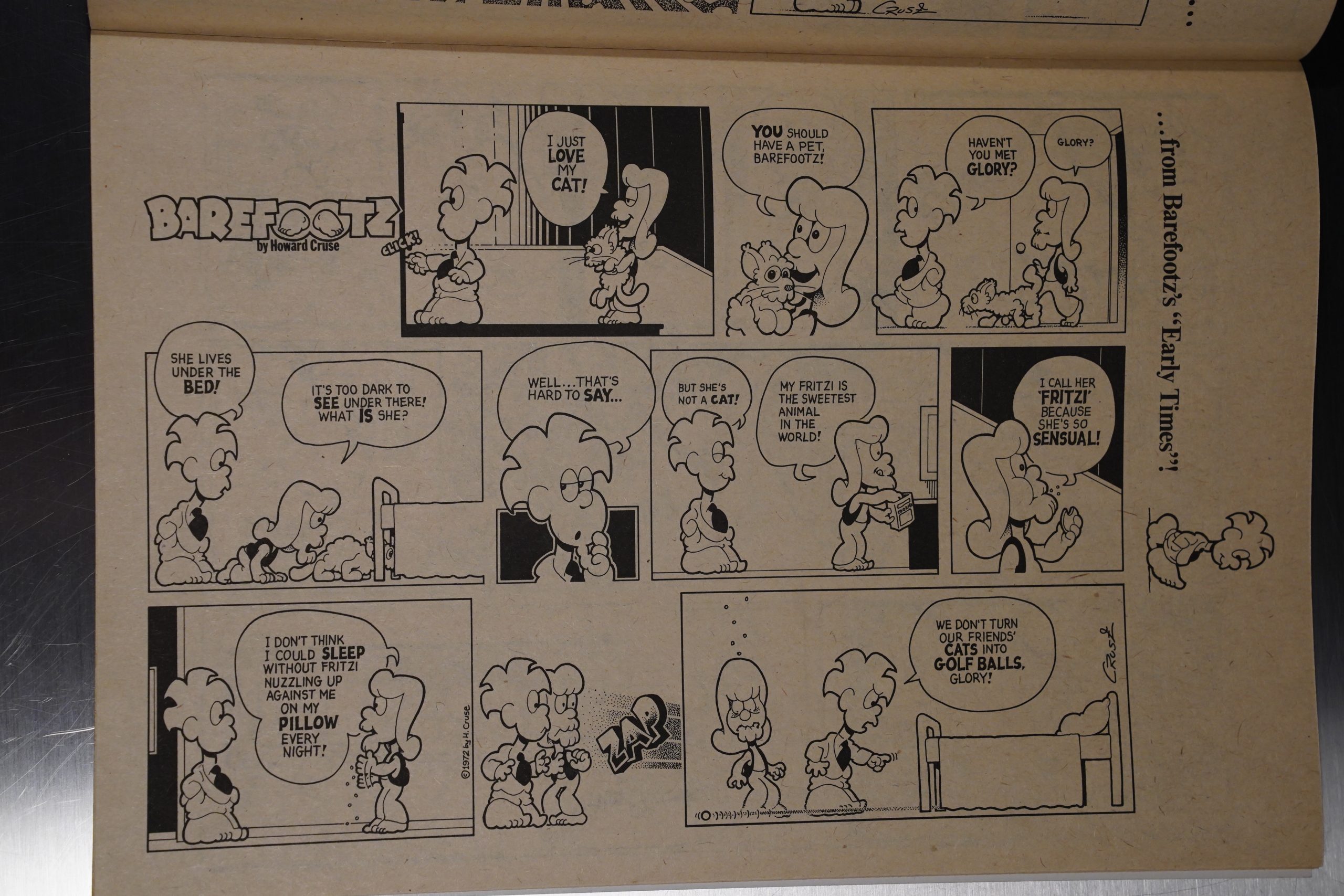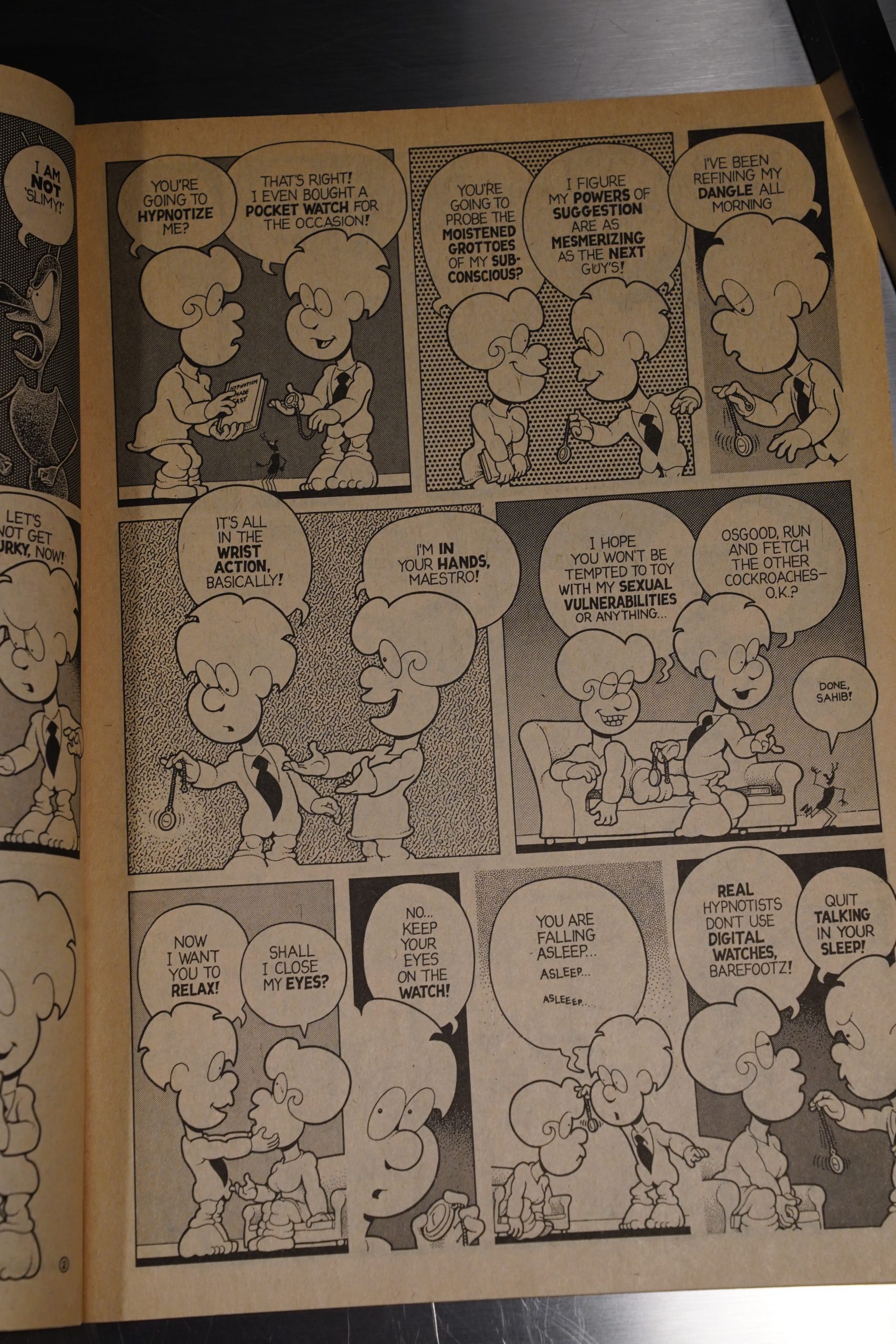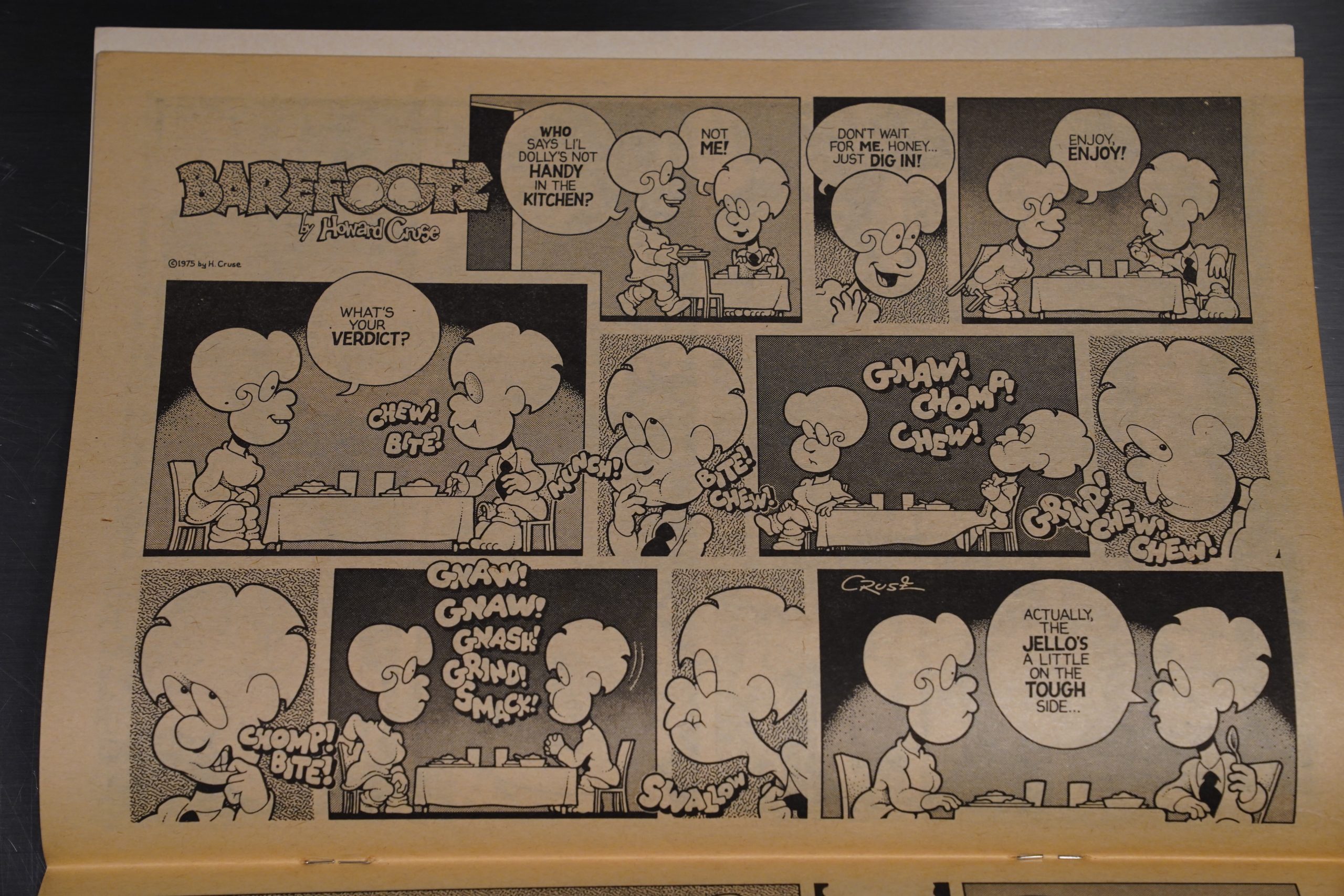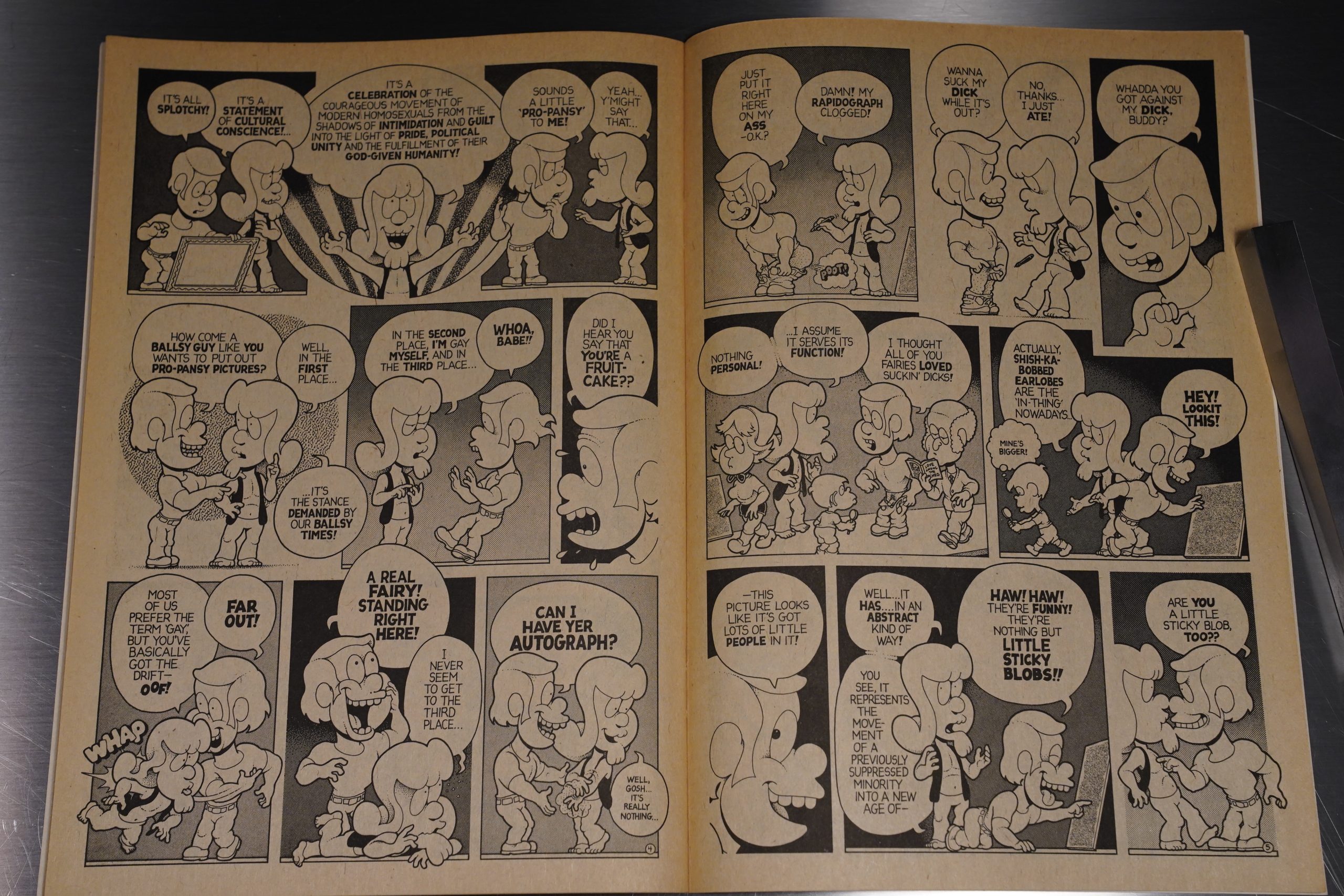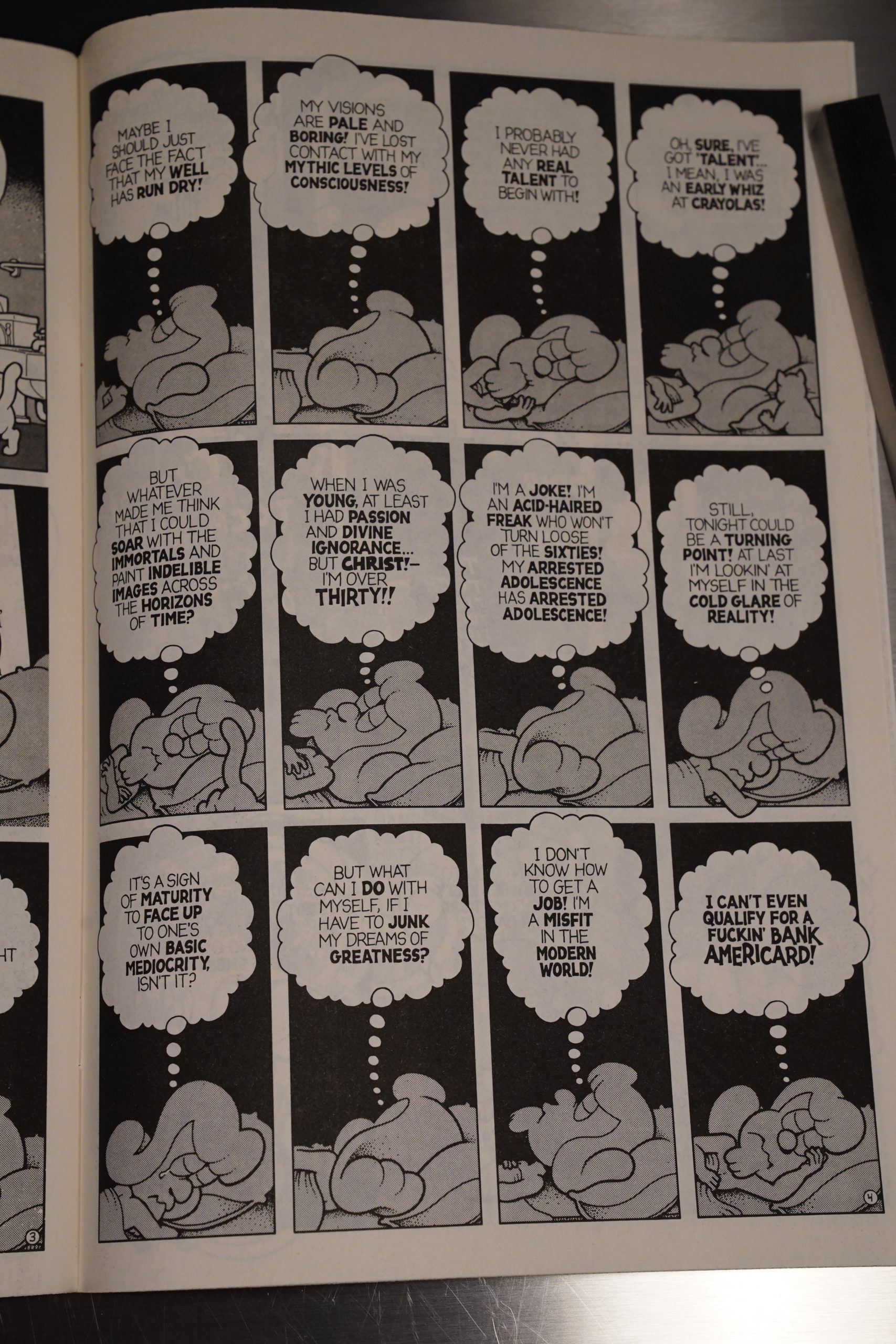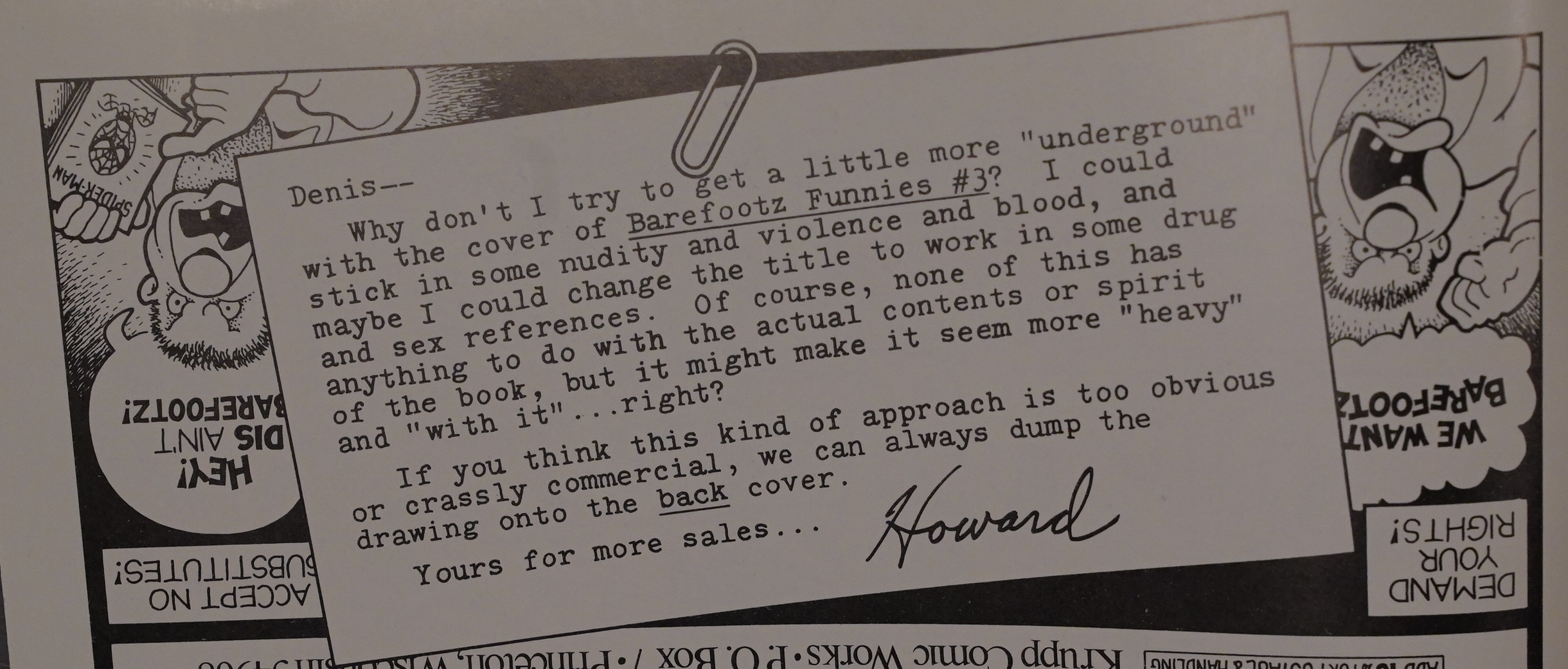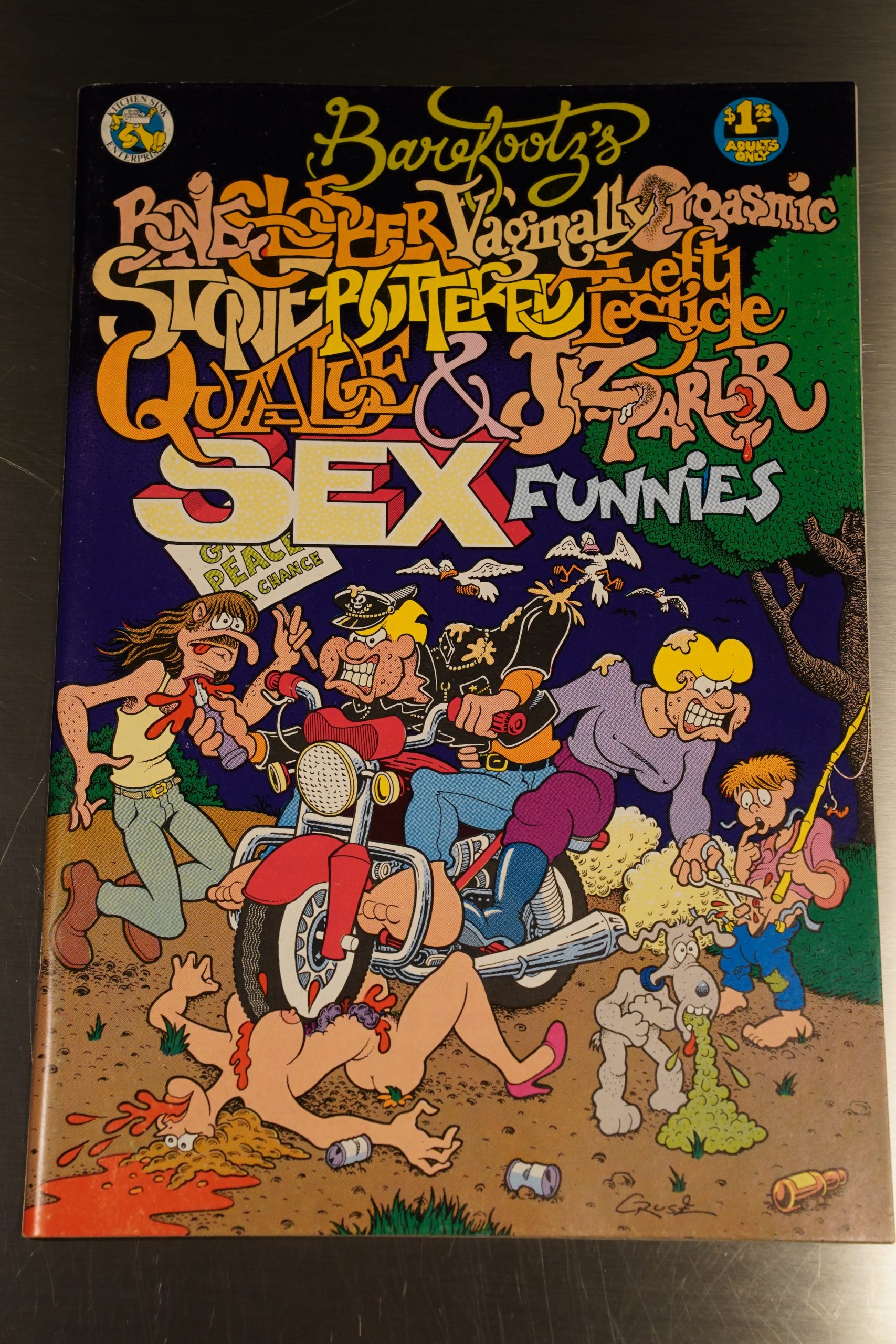Barefootz Funnies (1975) #1-3 by Howard Cruse
Kitchen Sink only launched two new series in 1976 — one was the one-shot Consumer Comix (financed by the US gummint), and this is the other one — and it’s co-published with Woofnwarp Productions. Which makes me wonder whether perhaps they put up the money for this, and Kitchen handled the practicalities?
Anyway, as much as I like Howard Cruse (and I do like him a lot), I never got around to buying (and reading) this series until now. There was a Barefootz collection published… but I’m not sure it reprinted the stuff from this series?
And this series itself is half new(ish) stuff (like the above) and reprints of the Barefootz strip that Cruse was running in some newspapers, I think.
And here’s a reprint, I guess.
Heh. I guess Cruse had bought a lot of different zip-a-tone and wanted to try it out? In any case, I think the newer stuff is a lot more amusing than the newspaper strips, because too many of them are like this:
That is, charmingly illustrated and well paced, but with somewhat groan-worthy punch lines.
I enjoyed reading these three issues a lot, but there’s a palpable sensation of Cruse flailing around a bit, trying to break free of the formula he’d established. So we get two long Headrack stories (he’s Barefootz’ gay artist friend), and they’re… quite different from the Barefootz stories.
And indeed, the final issue feels like a farewell to the Barefootz era. The first story of the issue (looking to be the last story completed, perhaps?) is all meta and ruminative.
And we get a Headrack story about being dissatisfied with the art you’re doing (and not being able to sleep). Nowhere on the pages does Cruse come out and say “I’m done with Barefootz”, but the feeling is palpable.
Oh, and there’s a bonus, more commercial extra cover on the back:
See? Much more commercial.
Kitchen is interviewed in The Comics Journal #63, page 224:
SHERMAN : How did Howard Cruse’s relationship with
Krupp start?
KITCHEN : He had created Barefootz and it had had
some limited circulation in some alternative papers, par-
ticularly in Birmingham, Alabama which was his home.
But he hadn’t had any really wide exposure. I liked
his stuff from the start, though Vve probably been more
criticized for publishing Barefootz than anything sexist
that Crumb did or something obscene that anybody might
have drawn. He’s an amazingly controversial cartoonist.
I get letters and personal complaints from people saying,
“How can you publish this cutesy nonsense? It has no
place in underground comics. And other people say,
“This is my favorite stuff, this is hilarious, this is
great,” and it’s one of those love-or-hate situations.
Now , the surprising development has been in recent
months , particularly since his Little Lulu parody
appeared in Snarf, and since Barefootz Some of his
harshest critics have come to appreciate his work, or at
least the direction his work has taken. He’s developing
a more realistic style—well, (laughter] “realistic” isn’t
the right word. He’s drifting away from the strict
Barefootz style and he’s developing a more realistic
technique that doesn’t seem to bother people so much.
Barefootz seemed to come from kind of a Gerald McBoing-
Boing school of art and his new style is much more
palatable to comix fans. His writing has always been
clever, but some people couldn’t get past the simple art
style. I think his newer work is opening a lot of eyes.
SHERMAN: There’s also an increased emphasis on
character instead of just straight gag strips.
KITCHEN: That’s right. But he is a very good gag
cartoonist and I have no doubt that he could be a very
popular syndicated cartoonist if fie chose to go that
route. But he’s much more interested in the complete
freedom the underground offers , and that’s one of the
great things. You can’t quite define what an “under-
ground” is, but it sure appeals to a lot of people. And
it’s that indefinable freedom. He would not have to
sacrifice a lot to be nationally syndicated, but he’s not
willing to sacrifice that little bit. “That little bit” turns
out to be a great deal, and is invaluable to many artists.
Cruse is interviewed in The Comics Journal #111, page 86:
RINGGENBERG: In Barefootz, started
using things like Zip-a-Tone screens.
CRUSE: Yeah, that was when Comix Book
was in its formative stages. Denis Kitchen
wanted to use Barefootz as a regular feature,
and Stan Lee had problems with the fact
that there was so much white on the pages.
It had a coloring-book look to it.
RINGGENBERG: Yeah, you’ve got these
bold lines around everything.
CRUSE: Bold lines with a lot of white. So
Denis asked it if would offend me to •see
about adding some grays.
RINGGENBERG: The tones seem to work
within the context.
CRUSE: It worked fine. I mean, there was
a period in which I used Zip-a-Tone regularly
in Barefootz, and then, in the long run, I
quit doing it. The thing I didn’t like about
those benday screens—those are the ones
that give a flat, gray look—is that they also
give a cool, mechanical 100k. They don’t
give a warm feeling to the art. That began
to bother me.
The quality I love about Robert Crumb’s
stuff is the handcrafted look. You can’t miss
the fact that an actual human hand put
energy into drawing all of those marks on
the page. Once you start adding flat, gray
tones, it distances you from the drawing a
little bit. No hand could make dots that
perfect. You know a machine’s been around!
I experimented with the screens for a good
while. I think my Comix Book stuff and all
of Barefootz Funnies #2 used Zip-a-Tone. And
for continuity’s sake, I Zip-a-Toned the
Headrack story in Barefootz Funnies #3. But
by then I was becoming discontented with
it, and I use very little Zip-a-Tone now. I still
keep it around for special places where
nothing else will give the same effect, where
any kind of hand shading calls attention to
itself. Occasionally it’s just what you need—
a very neutral gray cast to things.[…]
RINGGENBERG: was the pseudo-under.
ground cover drawing (on Barefootz Funnies
showing Barefootz and Dolly as bikers your
way Of razzing people who thought your strip
was too cute?
CRUSE: I think the little memo on the
inside back cover makes that pretty clear.
Barefoot? was always getting put down as
being too sweet and cute for underground
comix, and this was my take-off on the rau-
chiness syndrome.
RINGGENBERG: If people had taken the
time to really read Barefootz it wasn’t all that
cute. There were some very disturbing things
in the strip on occasion.
CRUSE: That’s what 1 felt. That’s why 1
was really bothered that a certain segment
of the underground audience seemed deter-
mined to dismiss the strip as trivial and not
to see that its undercurrents were, as you
say, disturbing.
Man:
Barefootz Funnies rarely makes the list of any underground comic fan’s favorite comic books, but it was certainly a fascinating account of one comic creator’s evolution in real life.
This is the twenty-ninth post in the Entire Kitchen Sink blog series.
